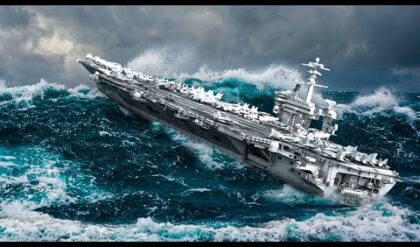The UK has announced its intent to fit land-attack strike capability to both its future frigate types. This decision has been precipitated by changing operational requirements for the UK Royal Navy (RN), due to conflict and wider instability in the maritime domain.

The UK Royal Navy’s Type 26 frigates will add land-attack capability, via their Mk 41 vertical launching systems. Lead ship Glasgow is pictured. Credit: Crown copyright/UK MoD, 2023
The UK government revealed the decision at the First Sea Lord’s Sea Power Conference, which is taking place at Lancaster House, London on 14-15 May. In the conference’s keynote address, UK Secretary of State for Defence Grant Shapps said:
“Today, I can announce that in the future we will be equipping our Type 26 and Type 31 frigates with land strike capability.”
Driving the decision, the Secretary of State explained, were events in the naval operating environment, including in the Red Sea. “Events in the Red Sea really do highlight the need for sea to land capability,” Shapps said.
Since November 2023, Yemen-based Houthi rebels have been targeting commercial and naval ships using the Red Sea/Bal-el-Mandeb/Gulf of Aden corridor, firing various land-launched weapons including ballistic and cruise missiles and uncrewed air and surface systems.
The RN has deployed the Type 45 destroyer HMS Diamond and Type 23 frigates HMS Lancaster and HMS Richmond to provide air-defence capability within the international coalition response.
However, the RN has not been able to strike Houthi launch and logistics sites ashore – like the UK Royal Air Force and US Navy have done – as the RN ships are not fitted with a long-range land-attack capability.
The strike capability fit for the future frigates is enabled by the presence onboard of the Lockheed Martin Mk 41 vertical launching system (VLS), a flexible launcher designed to accommodate different missiles. The Type 26s are fitted from build with Mk 41.
In May 2023 – at the previous First Sea Lord’s Sea Power Conference – First Sea Lord and Chief of Naval Staff Admiral Sir Ben Key announced that Type 31 would receive a Mk 41 fit: the system will be back-fitted into ships already in build.
“We made some decisions in the past with the Type 26 design where this was not an essential initial requirement. We’ve now recognised that the world has changed,” Adm Key told a media briefing at the 2024 conference.
The navy will now use the space and opportunity in Type 26 provided by Mk 41 to introduce this capability, Adm Key continued.
It will also introduce Mk 41 into Type 31 as soon as practical: the RN will not slow down the programme to add VLSs to the ships in build; instead, he explained, “We will do that at the first sensible opportunity.”
The surface ship fit decision reflects the RN’s requirement to expand its firepower options. “It is a recognition that having a land-attack strike capability is something that you can’t constrain to just a small number of ships or submarines: you need it to be as broadly [prevalent] as you possibly can.
That’s how you generate choice,” said Adm Key. “It’s quite clear that we’re being challenged from the land domain; therefore, we need more choice as to how we will engage [that].”
“We have a land-attack capability in our Astute-class submarines, but we don’t always have an Astute-class submarine in a part of the world where we need to engage with a threat ashore,” he added.

As regards missile systems, the land-attack requirement can be met by several options.
Adm Key said the navy has three strands to its thinking: the Raytheon/US Navy Tomahawk, which is already in RN service onboard its Trafalgar- and Astute-class submarines;
Norway’s Kongsberg-made Naval Strike Missile, which is already being fitted to several RN Type 23 frigates; and the UK-France Future Cruise/Anti-Ship Weapon (FC/ASW)
programme, which will generate a long-range strike capability in the form of the Future Offensive Surface Guided Weapon (FOSGW).
“From that, we create a degree of choice and in due course we will make the necessary investment decisions,” said Adm Key.
As the RN explores these choices, the net effect of the decision is clear, Adm Key explained: “The more ‘guns’ the better,” he said.
Together, the Type 26 and Type 31 frigate programmes are designed to deliver capability across the operational spectrum. The eight Type 26s are focused on the top end, with an emphasis on anti-submarine warfare (ASW) but with concurrent capacity to tackle other high-end naval warfighting tasks.
The five Type 31s are general-purpose surface ships, but with flexibility in design and capability to tackle various tasks across the spectrum.
For the Type 26s, lead ship Glasgow is in the water, with commissioning scheduled for 2026.
Three more are in build. For the Type 31s, lead ship Venturer is in build and is scheduled for launch in 2024. Ship two is under construction.





